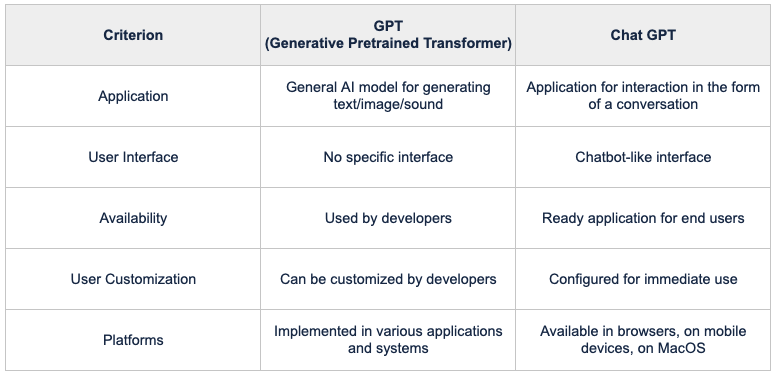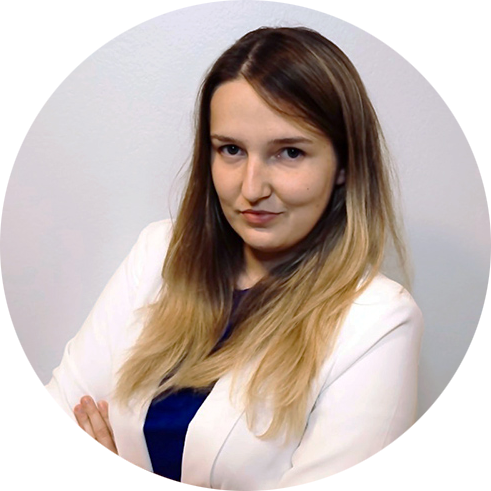GPT and its related ChatGPT have become incredibly popular lately. According to SimilarWeb data, ChatGPT currently boasts over 630 million users, and this number keeps growing.
But do you know what’s really behind these terms and how GPT differs from ChatGPT? In this article, we’ll break down these concepts in easy-to-understand language and explain why so many people and businesses have started using these solutions
What is GPT?
GPT (Generative Pretrained Transformer) is a series of language models developed by OpenAI, primarily designed to generate new content. Early versions of GPT mainly focused on creating human-like text. However, the latest versions can also process and create data in the form of images and sounds, making them what we call multimodal models.
GPT models are pre-trained on massive datasets, allowing them to predict the next words in a sentence and create coherent, contextually appropriate responses to questions.
Currently, OpenAI’s three flagship GPT models are GPT-4o, GPT-4, and GPT-3.5 Turbo.
What is ChatGPT?
ChatGPT is an advanced application based on GPT technology, also developed by the OpenAI team. It’s a conversational AI tool that allows users to input text prompts and receive human-like responses.
Initially, ChatGPT was only available as a web app. You can now use ChatGPT on your phone through a mobile app, and they’ve just rolled out a desktop version for Mac users.
OpenAI continues to improve and add new features to their tool. In the latest versions, users can save conversations and create custom chats (GPTs) to share with others.
ChatGPT’s Popularity
Since its market debut, ChatGPT has been incredibly popular. It surpassed 1 million users in just 5 days and reached 100 million users in 2 months. Currently, it’s estimated that about 637 million people use it.

Interestingly, about 62% of professionals use ChatGPT to help with their day-to-day work tasks.
What’s the difference between GPT and ChatGPT?
Let’s get back to the key question: How does GPT differ from ChatGPT? To sum it up, GPT is a versatile language model, while ChatGPT is a specific application based on this model, focused on user interaction.
To illustrate this even better, we’ve put together a table of key differences for you:

What Can GPT Models Do?
GPT models are incredibly versatile, with a wide range of applications. Here are some key examples of their capabilities:
- Answer questions and provide information: GPT can respond to diverse questions, offering precise and contextual information on topics across various fields.
- Content creation: These models can automatically generate content such as articles, social media posts, and even poems or song lyrics. They can provide inspiration, create outlines, or serve as a foundation for further editorial work.
- Translation: GPT can translate texts from one language to another, maintaining the context and meaning of the original text.
- Summarize long documents: The model can process lengthy documents and generate concise summaries, highlighting the most important information.
- Code generation and programming assistance: GPT can use programming languages, assisting developers in creating applications, debugging code, and finding solutions to programming problems.
- Image generation: The latest GPT models can create original graphics based on text descriptions provided by users.
- Learning and education support: GPT can generate educational materials such as textbooks, tests, exercises, and study guides, supporting teachers and students in the educational process.
- Idea generation: GPT can also be a source of ideas for daily life. It can easily generate dinner suggestions, weekend activity plans, or gift ideas. For example, it might suggest various recipes based on available ingredients or propose interesting places to visit in a specific area.
Business Benefits of Using GPT
Let’s now focus on the use of GPT in business. As you’ve probably noticed, more and more companies are implementing AI-based solutions, and recently, products using GPT have become particularly “trendy.” Why is there such great interest in this technology? Here are several key benefits prompting entrepreneurs to invest in these solutions.
Enhancing Product Value
Integrating GPT into products can significantly improve their functionality and value for users. For example, SEO text platforms can offer advanced text generation and analysis features that help companies rank higher in search engines. A case in point is the latest Semrush features, which assist users in responding to online reviews and finding the best keywords.
Creating New Revenue Streams
Implementing GPT-based features in products opens up possibilities for new business models and revenue sources. For instance, companies can offer premium subscriptions for advanced GPT-powered features. A prime example is Duolingo, which launched Duolingo Max – their new, top-tier subscription level, providing access to GPT-4 powered features like “Explain My Answer” and “Roleplay” exercises.
Increasing Competitiveness
In today’s market, no one wants to fall behind the competition. Implementing advanced technologies like GPT in products allows companies to stand out. Products with GPT-based features can attract new customers looking for innovative and advanced solutions.
Improving User Experiences
GPT can be integrated into customer support systems, offering instant answers to questions and helping with problem-solving, product discovery, or simple tasks like product returns and invoice generation. An interesting example is the use of artificial intelligence in tourism. Booking.com recently created the AI Trip Planner – a GPT-based tool that:
- Answers general travel questions
- Helps search for potential destinations and accommodation options
- Provides travel inspiration based on individual traveler needs and requirements
- Creates travel itineraries based on users’ personal preferences
Such solutions improve customer service quality and lighten teams’ workloads, allowing them to focus on more complex issues.
Enhancing Efficiency
GPT-based solutions can automate many tasks, particularly in customer service. For example, Klarna introduced a GPT-based assistant that handled 2.3 million customer conversations in its first month, accounting for two-thirds of all customer service interactions. The company calculated that their “automated employee” performs tasks equivalent to 700 full-time agents. Interestingly, the introduction of AI in this case did not affect customer satisfaction, with results comparable to those achieved by human agents.
Increasing Profits
Implementing GPT in products or integrating this technology into business operations can lead to significant profit growth. Again, Klarna is an example, expecting a $40 million increase in profits in 2024 due to the implementation of their AI assistant mentioned above.
Glossary of Terms and People Related to GPT
- OpenAI: An artificial intelligence research laboratory and company that created GPT models, ChatGPT app, and many other AI-based solutions. OpenAI was initially established as a non-profit organization due to the founders’ concerns about potential risks associated with uncontrolled AI use.
- Sam Altman: One of the founders and current CEO of OpenAI. Altman is a well-known technology entrepreneur and investor who previously worked as president of Y Combinator.
- Elon Musk: Co-founder of OpenAI, renowned entrepreneur and innovator, founder of companies like Tesla, SpaceX, and Neuralink. Musk was one of the main sponsors and initiators of OpenAI, supporting it financially and strategically. He later withdrew from active involvement in OpenAI to avoid conflicts of interest with his other AI ventures.
- Token: The basic unit of text used by GPT models. Tokens can be individual characters, words, or parts of words. GPT models process text at the token level, allowing for more detailed and precise response generation.
- Prompt: Text or question given to a GPT model as input, based on which the model generates a response. Prompts can be short or long and may contain varying levels of detail.
- Large Language Model (LLM): An AI model pre-trained on vast text datasets, enabling it to understand and generate highly precise natural language. GPT is an example of a large language model.
- Generative AI: A type of artificial intelligence capable of generating new data based on patterns and information contained in training data. Generative models like GPT can create texts, images, music, and other types of content that are difficult to distinguish from human-created content.
Summary
As you can see, GPT offers enormous possibilities for both businesses and individuals using applications that leverage this technology. It’s a powerful tool that can change the rules of the game in many markets and create new industry leaders.
Regarding the further development of GPT, OpenAI certainly hasn’t said its last word. More and more sources report that their team is working on the next version of the model, which may have significantly greater capabilities than its predecessors.
If you want to stay up-to-date, subscribe to our newsletter. There, we provide monthly updates on all the most important information from the world of artificial intelligence, ensuring you won’t miss any crucial news.
